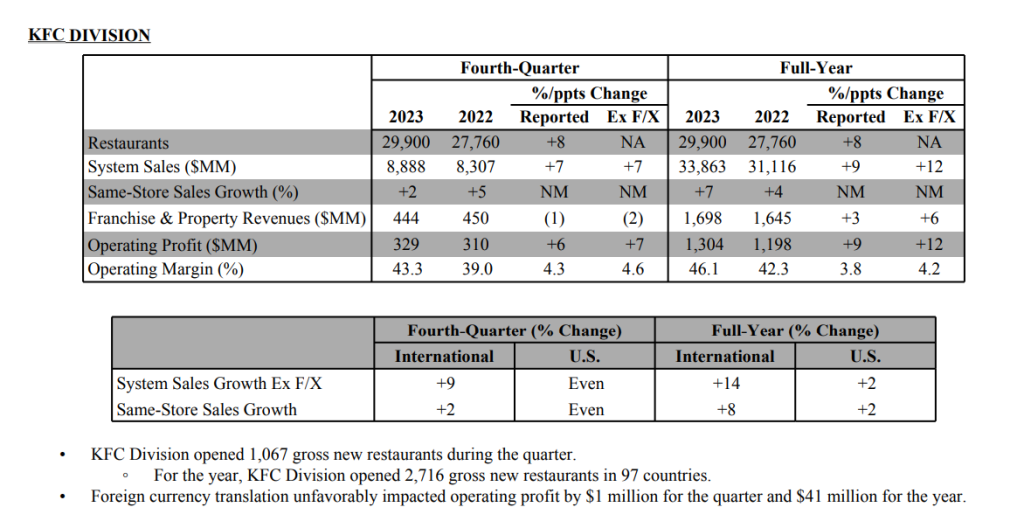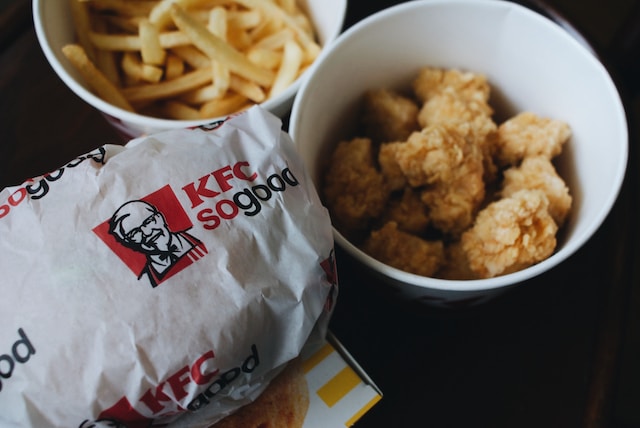Before we dive deep into the SWOT analysis, let’s get the business overview of KFC. Kentucky Fried Chicken, or KFC, is a global fast-food chain specializing in fried chicken. Founded by Colonel Harland Sanders in 1952, the company has become one of the world’s most recognizable and successful fast-food brands. Here is a brief overview of KFC’s business:
- Brand & Ownership: KFC is a subsidiary of Yum! Brands, Inc., which also owns other popular fast-food chains like Taco Bell and Pizza Hut. The iconic KFC brand is known for its secret blend of 11 herbs and spices, which is still used in chicken recipes.
- Menu: KFC’s core offering is its fried chicken, which comes in various forms such as Original Recipe, Extra Crispy, and Spicy. The menu also includes sandwiches, wraps, salads, sides, desserts, and beverages. KFC has also expanded its menu to accommodate local tastes in various markets, offering items like rice bowls, chicken curry, and grilled chicken.
- Global Presence: KFC has a strong international presence, with over 24,000 restaurants in over 145 countries. The brand’s most significant markets include the United States, China, Japan, the United Kingdom, and India. KFC continues to expand in both developed and emerging markets.
- Franchise Model: KFC primarily operates on a franchise model, where local entrepreneurs own and operate individual restaurants under the KFC brand. This model enables the company to expand quickly with lower capital investment and allows local operators to adapt the menu and operations to suit regional tastes and preferences.
- Innovation: KFC is committed to innovation, both in its menu and in its business operations. The company has been working on plant-based alternatives to cater to the growing demand for vegetarian and vegan options. In addition, KFC has been investing in digital technology to improve customer experiences, such as through online ordering, mobile payments, and delivery services.
- Corporate Social Responsibility: KFC has made efforts to address environmental and social issues. The company has committed to reducing its environmental footprint through initiatives like sustainable sourcing, energy efficiency, and waste reduction. KFC also engages in community outreach programs and supports various charitable organizations.
- Financial Performance: KFC Ltd reported earnings results for the full year ended March 31, 2023. For the full year, the company reported sales was JPY 13,031 million. Net income was JPY 1,052 million.

Here’s a SWOT analysis for KFC:
A SWOT analysis is a strategic planning tool used to evaluate the Strengths, Weaknesses, Opportunities, and Threats of a business, project, or individual. It involves identifying the internal and external factors that can affect a venture’s success or failure and analyzing them to develop a strategic plan. In this article, we do a SWOT Analysis of KFC.
SWOT Analysis: Meaning, Importance, and Examples
Strengths
- Strong brand recognition: KFC is one of the most recognizable fast-food brands in the world, with its iconic logo, Colonel Sanders’ image, and the famous secret recipe. This strong brand identity has helped KFC maintain customer loyalty and attract new customers.
- Unique product offering: KFC’s original recipe of 11 herbs and spices sets it apart from competitors in the fast-food market. The distinct taste of KFC’s fried chicken has helped the company maintain a competitive edge.
- Global presence: With over 24,000 restaurants in more than 145 countries, KFC has a broad reach and a strong international presence. This extensive network enables KFC to benefit from economies of scale and capitalize on growth opportunities in developed and emerging markets.
- Franchise model: KFC’s franchise model allows rapid expansion with relatively low capital investment. This approach also enables local franchisees to tailor the menu and operations to suit regional tastes and preferences, improving customer satisfaction and driving sales.
- Menu innovation: KFC continually adapts and expands its menu to cater to evolving consumer tastes and preferences. In addition to its core fried chicken offerings, KFC has introduced grilled chicken, plant-based alternatives, and various regional dishes to attract a broader customer base.
- Effective marketing strategies: KFC employs innovative and culturally relevant marketing campaigns to maintain brand visibility and engage customers. By leveraging digital platforms and social media, KFC can connect with its audience and generate buzz around new products and promotions.
- Digitalization and technology: KFC has embraced technology to improve the customer experience, such as through online ordering, mobile payments, and delivery services. These efforts create convenience for customers and help KFC gather valuable data to optimize its operations and marketing efforts.
- Supply chain management: KFC’s efficient supply chain management allows the company to maintain consistent quality and taste across its global network of restaurants. By working closely with suppliers and distributors, KFC can ensure the timely delivery of ingredients and minimize disruptions to its operations.
Weaknesses
- Health concerns: KFC’s primary offerings of fried chicken and fast food have been criticized for their high calorie, fat, and sodium content. As consumers become increasingly health-conscious, this perception can negatively impact the brand’s image and customer loyalty.
- Limited product diversification: While KFC has expanded its menu over time, its core offerings still revolve around chicken-based dishes. This limited product diversification can make it challenging for KFC to cater to diverse consumer preferences and dietary restrictions.
- Dependence on the franchise model: KFC’s franchise model, while providing opportunities for rapid expansion, can also create challenges in maintaining consistent quality and operational standards across its global network of restaurants. Franchisees may not always adhere to the company’s guidelines, leading to inconsistencies and negatively impacting the brand image.
- Intense competition: The fast-food industry is highly competitive, with numerous players vying for market share. KFC faces direct competition from other major fast-food chains, such as McDonald’s, Burger King, and Chick-fil-A, as well as from smaller, specialized restaurants and local eateries.
- Ethical concerns: KFC has faced criticism over animal welfare, supply chain sustainability, and labor practices. Failure to address these concerns can result in negative publicity and damage the brand’s reputation.
- Vulnerability to economic fluctuations: As a fast-food chain, KFC can be susceptible to economic downturns and changing consumer spending patterns. During recessions or periods of economic uncertainty, consumers may reduce spending on discretionary items like dining out, impacting KFC’s sales and profitability.
- Slow response to market trends: In some cases, KFC has been slow to adapt to evolving consumer preferences and market trends. For example, the company has been relatively late introducing plant-based alternatives compared to some of its competitors, potentially missing out on opportunities to capture market share in this growing segment.
Opportunities
- Healthier menu options: As consumers become increasingly health-conscious, KFC can expand its menu to include healthier options such as grilled chicken, salads, and plant-based alternatives. This will help the company cater to a broader audience and mitigate the negative perception associated with traditional fast food.
- Plant-based alternatives: The demand for plant-based protein is growing rapidly as consumers seek more sustainable and ethical food choices. KFC has the opportunity to expand its plant-based offerings and capitalize on this trend, attracting new customers and increasing market share.
- Expansion in emerging markets: KFC can continue to expand its global presence, particularly in emerging markets with growing middle-class populations and increasing disposable incomes. Countries such as India, Brazil, and Africa offer significant growth potential.
- Technology and digital initiatives: KFC can further invest in technology to enhance the customer experience, streamline operations, and improve efficiency. This can include initiatives such as mobile ordering, delivery services, AI-driven customer analytics, and the implementation of smart kitchen technologies.
- Customization and personalization: KFC can better cater to individual preferences and dietary requirements by offering greater customization and personalization options. This can help the company differentiate itself from competitors and build customer loyalty.
- Strategic partnerships: KFC can explore strategic alliances with other businesses, such as grocery stores or meal-kit providers, to expand its distribution channels and reach new customers.
- Sustainable and ethical practices: By addressing issues related to animal welfare, environmental sustainability, and labor practices, KFC can enhance its corporate social responsibility efforts and improve its brand image. This can include initiatives such as sourcing ingredients from sustainable and ethical suppliers, reducing waste, and promoting fair labor practices.
- Diversifying revenue streams: KFC can explore new revenue streams, such as catering services, co-branding opportunities, or licensing its brand for consumer packaged goods. This can help the company diversify its income sources and reduce dependence on traditional restaurant sales.
Threats
- Intense competition: The fast-food industry is highly competitive, with numerous established chains and emerging players vying for market share. KFC faces direct competition from major fast-food brands like McDonald’s, Burger King, and Chick-fil-A, as well as local and regional competitors. This competition can result in pricing pressures, reduced market share, and the need for constant innovation to stay ahead.
- Health-conscious consumer trends: As consumers become increasingly concerned about the health implications of fast food, KFC’s traditional fried chicken offerings could be negatively impacted. The company must adapt its menu to accommodate evolving consumer preferences for healthier, more sustainable food options.
- Economic fluctuations: Global economic conditions and consumer spending patterns can affect KFC’s business. During economic downturns or periods of uncertainty, consumers may cut back on discretionary spending, including dining out, which could negatively impact KFC’s sales and profitability.
- Supply chain disruptions: KFC’s business relies on a complex global supply chain, susceptible to disruptions due to geopolitical tensions, natural disasters, and pandemics. These disruptions can lead to increased costs, operational challenges, and potential damage to the brand’s reputation.
- Changing regulations and compliance: KFC operates in multiple countries, each with its own regulations and compliance requirements. The company must navigate these varying rules and regulations, which can be both costly and time-consuming. Additionally, new regulations, such as those related to food safety, environmental impact, or labor practices, could impose further constraints on KFC’s operations.
- Ethical and environmental concerns: KFC has faced criticism related to animal welfare, environmental sustainability, and labor practices. Failure to address these concerns can result in negative publicity, brand reputation damage, and potential legal consequences.
- Data security and privacy: As KFC increasingly relies on technology and digital platforms to improve operations and customer experience, the company faces the risk of data breaches and cyberattacks. Ensuring data security and maintaining customer trust are crucial for KFC’s success.
- Currency fluctuations: As a global business, KFC is exposed to currency fluctuations, which can impact its financial performance. Changes in currency exchange rates can affect the company’s revenue, costs, and profitability.











